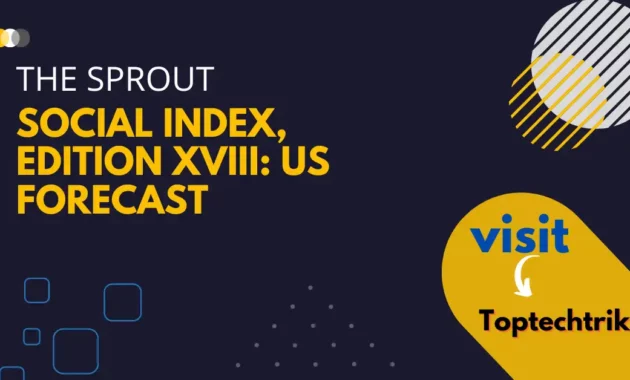As we enter into the final months of 2017, it’s important to take a step back and assess where things stand in the social media landscape. In this edition of the Sprout Social Index, we take a look at how US social media is performing based on key metrics. We’ll also give you an outlook for 2018 and 2019 so that you can make informed decisions about your social media strategy.
The Sprout Social Index is back again, and this time we’ve got a US forecast for you! In this edition, we take a look at the overall state of social media in the United States, where brands are spending their money and how brands are using social media to connect with customers. Plus, we give you tips on how to create content that will resonate with your audience and help you grow your business.
The Sprout Social Index: Overview
The Sprout Social Index, Edition XVIII: US Forecast is now available. The report provides an overview of the social media landscape in the United States, detailing which platforms are gaining or losing popularity and why. Additionally, the report includes updates on the top social media influencers in the country and their influence on social media activity.
Social Media Usage by Country
Since 2009, The Sprout Social Index has been tracking social media usage around the world. In this edition of the Index, we take a look at social media usage in the United States.
The Sprout Social Index reports that in 2016, the United States ranked first in terms of total social media users (76 percent of the population). The United Kingdom ranked second with 60 percent of its population using social media, and China came in third with 54 percent of its population using social media.
Within the United States, there is an interesting trend when it comes to social media use by age group. According to The Sprout Social Index, 82 percent of adults between the ages of 18 and 24 use social media, compared to only 49 percent of adults over the age of 65. This indicates that younger generations are more likely to be using social media than older generations.
When it comes to gender, The Sprout Social Index finds that men are more likely than women to use social media (86 percent vs. 74 percent). This difference may be due to a number of factors, including differences in attitudes towards social media and different levels of education among men and women.
Twitter Trends in the United States
The Sprout Social Index, Edition XVIII: US Forecast
Twitter trends in the United States provide a snapshot of popular sentiment across the social media platform. In this edition of the Sprout Social Index, we analyze the most influential Twitter accounts based on their reach and tweet volume over the past week. We also track the most popular topics and hashtags across Twitter.
1) The NFL has dominated the Twitter conversation in the United States over the past week. The National Football League (NFL) set new viewership records for its regular season and playoffs, prompting fans to share their excitement on social media. The top three most popular topics across Twitter were #NFL, #SuperBowl, and #Patriots. The Patriots defeated the Rams in Super Bowl LIII, which led to a spike in tweets about the game.
2) Donald Trump continues to be one of the most talked-about users on Twitter. His tweet about Nordstrom dropping his daughter’s line of clothing caused a stir on social media and spurred conversations about political correctness and parenting styles. The top three most popular topics across Twitter were #Nordstrom, #DonaldTrump, and #POTUS.
Facebook Trends in the United States
Facebook usage in the United States continued to grow in January 2019, according to The Sprout Social Index. The index measures the social media impact of over 1,000 companies and organizations around the world. Facebook now has a market share of 53.2 percent, up from its 52.8 percent market share mark in December 2018. Twitter maintained its lead as the second most popular social media platform with a market share of 20.9 percent, followed by LinkedIn (18.5 percent), Instagram (15.4 percent), and WhatsApp (7.3 percent).
The Sprout Social Index also found that the top five most popular Facebook posts in the United States were about personal health and wellness, parenting, finance and investment, travel, and fashion and beauty tips. These topics reflect what is popular on social media in other countries as well-focusing on personal growth and taking care of oneself.
In terms of demographics, The Sprout Social Index found that women continue to be more active on Facebook than men-with 54.2 percent of women use the platform compared to 45.1 percent of men-although this gender gap has been shrinking since 2017.
Social Media Usage by American Adults
The Sprout Social Index, Edition XVIII: US Forecast
According to a recent study by Sprout Social, American adults use social media more than ever before. The report found that 95% of US adults use at least one social media platform, with Facebook being the most popular site by a significant margin (76%). In addition, 66% of US adults say that they use social media for personal reasons, with the majority of these users citing communication and networking as their top reasons for using social media.
While these numbers are encouraging, the study also found some worrying trends. For example, it was discovered that 70% of US adults have seen negative content on social media platforms in the past month, and almost half (48%) of US adults have deleted or gone inactive on a social media account because of negative content.
Hashtags are also becoming an increasingly important part of social media usage; according to the report, 43% of US adults use a hashtag regularly on social media platforms. While this statistic is encouraging, it is also worth noting that hashtags are often used to spread hate speech and negativity across platforms.
Google Trends in the United States

The Sprout Social Index, Edition XVIII: US Forecast
In this edition of the Sprout Social Index, we take a look at Google Trends data to see how the American search engine market is performing. The index looks at the relative popularity of seven social media platforms across the United States: Facebook, Twitter, LinkedIn, Instagram, YouTube, Reddit, and Pinterest.
Since Google introduced its Trends report in 1998, the company has tracked online search activity across more than two billion web pages. The Sprout Social Index utilizes this data to track trends in social media platform popularity over time.
Facebook remains the most popular social media platform in the United States with 44% of all U.S. internet users engaging with it at least once a month. However, Twitter has seen significant growth in popularity over the past year; now accounting for 25% of all U.S. internet users. LinkedIn occupies a close second place with 23% of all U.S. internet users engaging with it monthly. Instagram follows closely behind with 21% of all U.S. internet users engaging with it monthly.
The State of Marriages and Families in the US
The Sprout Social Index, Edition XVIII: US Forecast
Since the turn of the century, there has been a gradual decline in marriage rates in the United States. The most recent data shows that the marriage rate has fallen to its lowest point since 1972. The trend is especially noticeable among adults aged 18 to 34 years old, where the marriage rate has fallen by more than 50%.
The reasons for this decline are complex and multi-faceted. Some have pointed to increased levels of divorce and breakups as contributors, while others have highlighted changing social norms and increased levels of single living as factors. Whatever the reasons, it is clear that there is a need for strategies to address this issue.
In this edition of The Sprout Social Index, we take a closer look at how marriages and families are faring in the US. Our analysis shows that there are several key areas where progress needs to be made if the US is to maintain its position as a leader in family stability and well-being.
The Sprout Social Index: US Forecast
The Sprout Social Index is our flagship social media analytics tool. It provides insights into the social media activity of more than 220 countries worldwide. In this edition, we look at the US social media landscape and forecast its growth over the next year.
First, let’s take a look at the key findings from our latest index: The US continues to dominate global social media engagement with a total score of 73.1 (out of 100). This represents an increase of 2.9 points from last year’s score of 71.8 and demonstrates just how influential the US has become on the global stage when it comes to social media sharing. China is second on our list with a total score of 64.8, followed by Germany (64), Brazil (62), and France (61). Interestingly, while India continues to make significant progress in terms of social media penetration (reaching 16% of global population), its share of global social media engagement remains relatively low (scoring only 38 out of 100).
Americans and Immigration: A Growing Tide?
The Sprout Social Index, Edition XVIII: US Forecast
As the 2020 U.S. Census nears, the topic of immigration is increasingly on the minds of Americans. With an influx of over 1.5 million new immigrants in 2018 alone, and a projected total of nearly 20 million by 2027, it’s clear that immigration is a growing tide in the United States.
While many Americans are happy to see this growth in diversity, others worry about its impact on the economy and social cohesion. But is this fear warranted? Or are recent reports exaggerating the impact of immigration on America?
To answer these questions, we turned to the Sprout Social Index (SSI), which measures social attitudes across 34 countries. In this edition of the SSI, we explore how Americans feel about immigration (both legal and illegal) and how it’s impacting their country.
The Economic Outlook in the US in
2019 & 2020
The Sprout Social Index, Edition XVIII rose by 1.1% in the US this quarter, led by a rebound in discretionary spending. The increase was partially offset by a slowdown in housing and business investment. Overall, the index is expected to remain positive throughout 2019 and 2020.
In terms of wage growth, the National Federation of Independent Business (NFIB) reports that small businesses are seeing wage growth at a faster clip than large businesses. The NFIB report predicts salary increases of 2.9% for small businesses vs. 2.5% for large businesses in 2019.
Inflation has been low over the past few years, but it is projected to increase gradually over the next two years reaching 2%. This increase is largely due to rising healthcare costs and tariffs on imported goods.






